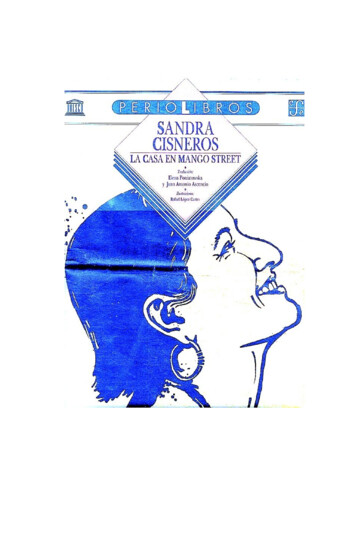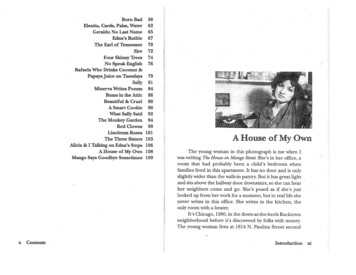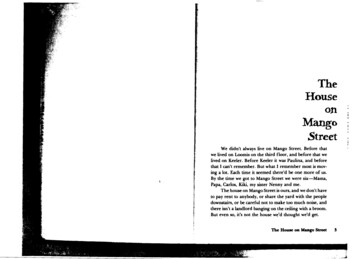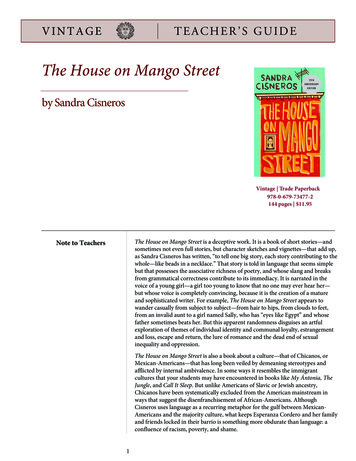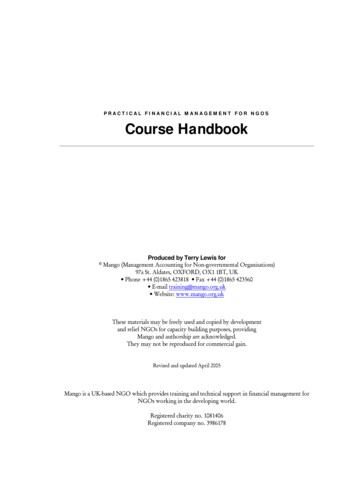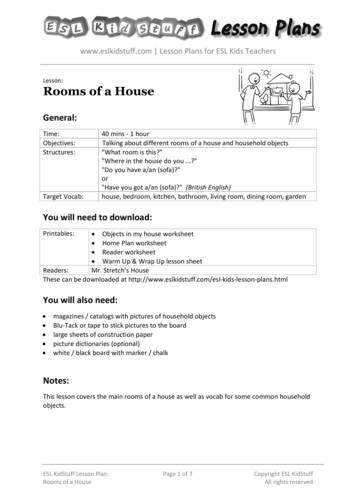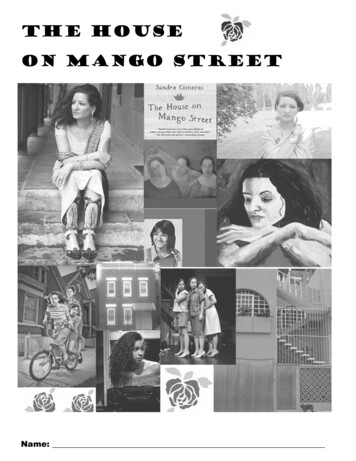
Transcription
The Houseon Mango StreetName:
2 Page
Table of ContentsElements of Style . 5Character Map . 6Pre-Reading Overview . 7-8“Hairs” Assignment . 9“Hairs” Samples. 10Before-After Reading Chart. 11“911 Disappeareds” Article . 12-14PICTO-DIDLS . 15-16Open Mind . 17Mango Quilt Squares . 19-20Double Entry Journal . 21-22Interpretive Essay Assignment . 23Interpretive Essay Outline . 25-263 Page
4 Page
Elements of StyleStyle—the distinctive way in which a writer uses language, from how he/she puts sentences together to his/her choice ofvocabulary and use of literary devices.Metaphor—a comparison between two things that are basically dissimilar in which one thing becomes another.Example: “But my mother’s hair is the warm smell of bread before you bake it.”Simile—a comparison between two things that are basically dissimilar using “like” or “as” to make the comparison.Example: “My papa’s hair is like a broom.”Personification—the act of giving human qualities to something that is not human.Example: “And me, my hair is lazy.”Alliteration—the repetition of similar consonant sounds within a phrase or sentence.Example: “It is the smell when she makes room for you on her side of the bed still warm with her skin.Repetition—the act of repeating words or phrases for dramatic effectExample: In “Hairs,” the words “hair,” “holding you,” and “rain” are repeated.Imagery—images and/or details that emphasize our senses (sight, sound, smell, taste, touch) to recreate a scene for thereaderExample: “The snoring, the rain, and Mama’s hair that smells like bread.”Onomatopoeia— The use of words whose sounds echo their meaningsDiction— The author’s word choiceVoice— The writer’s unique use of language that demonstrate the writer’s personalityTone— The writer’s attitude toward a subject, character, or event in a storyConnotation— An attitude or feeling associated with a wordDenotation— A dictionary definition of a word; its literal meaningIdiom— A common figure of speech whose meaning is different from the literal meaning of the words5 Page
CHARACTER MAPINSTRUCTIONS: As you read, fill out the following character map to keep track of character relationships6 Page
Name:English IIThe House on Mango Street—Pre-readingsOvervierw: For the next few weeks we will be reading, studying and analyzing Sandra Cisneros’ short novel,The House on Mango Street. The novel is made up of 44 short character sketches, or stories, called vignettes.Esperanza, a Mexican-American young woman who just moved with her family to Mango Street, narratesthem. Since the stories don’t really follow each other chronologically, we are going to read the novel in thethematic sections outlined for you below. We will be addressing different subjects and literary devices for eachset of stories. Before we discuss each section you will do a pre-reading assignment. Pre-readings should beabout 1 page.Section One: Self Definition and IdentityPre-reading question: What is the personal significance of your given name (first, middle and last)? Doesyour name mean different things to you, your family, and your friends? What are your nicknames? What doyour nicknames mean to you and those who call you those names?Read pp. 3-11 The House on Mango Street; Hairs; Boys and Girls; My NameSection Two: Friendship, Neighborhood, HomePre-reading question: Is living in a house your family owns different from living in a house or apartment yourfamily rents? How? Are renters, owners and homeless people all considered equal citizens in America? Whyor why not?Read pp. 12-25 Cathy Queen of Cats; Our Good Day; Laughter; Gil’s Furniture Bought and Sold; Meme Ortiz;Louie, His Cousin and His Other CousinSection Three: Freedom and EntrapmentPre-reading question: In what areas of your life are you most free to do what you like? In what areas of yourlife do you have the least freedom? Consider the roles gender, race, religion, education, class, age, andupbringing play in limiting an individual’s personal freedom.Read pp. 26-38 Marin; Those Who Don’t; There Was an Old Woman ; Alicia Who Sees Mice; Darius and theClouds; And Some MoreSection Four: Growth and Maturity, SexualityPre-reading question: How is growing into a teenage body (physically, mentally and emotionally) like movinginto a new house/apartment? Compare the experiences of moving into a new house/apartment to theexperiences of being a teenager.Read pp. 39-55: The Family of Little Feet; A Rice Sandwich; Chanclas; Hips; The First Job7 Page
Section Five: Gender Roles and ExpectationsPre-reading question: Should parents/guardians raise their teenage girls in the same way that they raisetheir teenage boys? Why or why not? What rules should be the same for girls and boys? What should bedifferent? Do you have brothers, sisters, cousins, etc. who are treated differently from you because of gender?Explain.Read pp. 56-73: Papa Who Wakes Up Tired in the Dark; Born Bad; Elenita, Cards, Palm, Water; Geraldo NoLast Name; Edna’s Ruthie; The Earl of Tennessee; SireSection Six: Fitting inPre-reading question: Describe a situation where you once felt really out of place or uncomfortable. Why didyou feel this way? What does the word “outcast” mean? What kinds of attributes make people into outcasts?Why must society have outcasts?Read pp. 74-87: Four Skinny Trees; No Speak English; Rafaela Who Drinks Coconut and Pineapple Juice onTuesdays; Sally; Minerva Writes Poems; Bums in the AtticSection Seven:Pre-reading question: What parts of your life would you most like to escape? Can you escape theseelements at some point in your life? If so, how? If not, why not?Read pp. 88-102: Beautiful and Cruel; A Smart Cookie; What Sally Said; The Monkey Garden; Red Clowns;Linoleum RosesSection Eight: Finding One’s “Home”Pre-reading question: What inspires you most in life? What do you see your future holding for you? Whatobstacles might stand in your way? In what ways will you attempt to overcome them and achieve your futuredesires?Read pp. 103-110: The Three Sisters; Alicia and I Talking on Edna’s Steps; A House of My Own; Mango SaysGoodbye Sometimes8 Page
Name:English IIASSIGNMENTWriting Situation:In the vignette “Hairs,” Sandra Cisneros reveals a lot about the narrator’s family, especially her mother, througha discussion of one physical trait: hair. Her first paragraph describes the hair of the narrator’s father and thehair of her siblings, using those descriptions to give the reader insight into each of their personalities. Cisnerosalso reveals the narrator’s feelings towards her mother in the passage, using a variety of stylistic devices toachieve this effect. Think about the people in your own family, the characteristics you share with them andthose which make them (and you) distinctive. Decide which physical trait you would like to write about. Is thetrait one you share with your family or yours alone? How might you present your piece Cisneros did withmetaphors, similes, personification, alliteration, repetition and sensory details?Prewriting DirectionsDue:Number your paper, write the following prompts, and answer them:1. SUBJECT: Who will you write about? (Yourself? Family member(s)? A close friend?)2. PERSONALITY TRAIT: What is special about that person? What is their personality like? What setsthem apart or makes them interesting? What favorite memories do you have about them?3. PHYSICAL TRAIT: What physical trait (part of their body) will you write about them? How can youmake that trait reflect their personality?4. ELEMENTS OF STYLE: What four different elements of style from the style sheet will you use todescribe their physical trait and personality?Writing DirectionsDueNow that you have done some thinking and prewriting about your subject, using your prewriting and thevignette “Hairs” as a model, write a vignette about your subject that discusses an important physical trait andhow it reveals something about the person who possesses it and your relationship to him/her. You maychoose to discuss a trait that you share with your subject, or one that makes a particular family member—oryou—stand out from the others because it is different. You must incorporate at least four different stylisticdevices in your vignette. Your vignette must be at least eight typed lines (not sentences) long (maximum of12 pt font), or one handwritten page.9 Page
Student Sample #1: Hairs ModelingLipsMy mom says my lips are like my grandpa, her father. My lips are nice and smooth like the skin of a shark or aground with no cracks in it. Everyone says that I am always looking mad like a mad dog. To me, I feel as if Idon’t have to smile unless something is funny or I want to. My lips are sad most of the time because I ambored.My sister says I have a big mouth, which is like saying I have big lips also. Maybe it’s because of whatevercomes out of it. She says this and the word big reminds me of an ugly fish. My mom says I talk too much andthat everything that comes out of my mouth has to be a smart remark. Maybe. But I like my lips. Theydescribe me.Student Sample #2: Hairs ModelingSkinEveryone in my family has different skin colors. Even though we are family, our skin colors are differentbecause we all come from at least three other places: Africa, the Northern Plains, and Europe. Black. Indian.White. That’s why I think my family and I have different skin colors.My grandmother on my mom’s side is light skinned like a fresh banana, mixed with black, white and Indian. Mygrandfather on my mom’s side is dark skinned like a dark brown crayon and mixed with black and Indian.Their child, my mom, is also dark like a dark brown crayon. Black, white and Indian.Both of my parents are mixed with black, white and Indian, which makes me light, lighter than both of them.Even though we all look different, somehow we are as one. After all the ancestry and the two sides of myfamily coming together, I was the one. Togetherness.The color of my skin reveals who I am, where I came from, what I am all about. It is what identifies me. Myancestry. Where it all started.10 P a g e
11 P a g e
12 P a g e
13 P a g e
14 P a g e
15 P a g e
16 P a g e
Name:English IIThe House on Mango Street—Open MindDirections: Put yourself into Esperanza’s place at the end of p. 89. Fill in the open mind diagram below withobjects, images, symbols and quotations from the story to provide a picture of what might be going through hermind. Be sure that you follow each quote with the page number on which it appears. You must includeat least 2 quotations in your open mind.Extra Credit: On the back of this sheet write a paragraph explaining what you drew and wrote inside the openmind.17 P a g e
18 P a g e
Name:English IIMango Street QuiltBecause Mango Street is a community, everyone is connected, like many colored squares ona giant quilt. They touch each other in both positive and negative ways. They are stitchedtogether into their neighborhood. So today, I’d like you to create a Mango Street patchwork.You’ll each create two squares of the quilt, and after I grade them, I’ll put them up in the halloutside to create a giant Mango quilt pattern for your period -- Enjoy!1. Choose two important moments, characters, symbols, or images from the novel. Whatvignettes do you remember most so far? Which scenes still stick in your head? Whatpictures from the book do you see in your head? Pick two moments, characters, orimages from the book to draw.2. Choose two different color squares3. Write your name in the bottom right corner of each square4. Write a quote on each square that connects to the image/moment/character you havechosen5. Draw a scene, a person, or an image from the book on each square that connects toyour quote.6. On the back of each square, you should write the name of the vignette yourimage/moment/character comes from and explain your reasoning for selecting theevent or character you portrayed. Why is it important to Esperanza and/or the story?19 P a g e
Esperanza“In English, my namemeans hope .It is amuddy color It is likethe number nine .Atschool they say myname funny as if thesyllables were madeout of tin and hurt theroof of your mouth ”(Cisneros 10).“My Name”I drew the way Esperanza views hername, so I drew a muddy number nine,and made her name look sharp so it cutsa mouth.This vignette seems important to mebecause I think it shows howEsperanza's name is part of who she is.It shows how she looks down on herselfbut also how she strives to be more.She wants to be more than a woman bythe window but she feels insecure abouther name and who she is.20 P a g e
Name:English IIMango Street—Double Entry Journal (DEJ)Overview: A Double Entry Journal (DEJ) is a way to closely read passages from a text, to discover whatindividual words and sentences reveal about characters, conflicts, themes, etc. In the future, you will be selectingyour own “strong lines” and meaningful passages to comment on, but for this first effort three have been chosenfor you. Each passage shows something about Esperanza, her relationship to someone else in the neighborhood,and/or her opinion about a particular social issue.Directions: As you read each passage, you have five tasks: First, identify who is speaking or narrating.Second, explain what the context or situation is—that is, who is involved, where s/he is, at what time, and whatis going on, etc., Third, explain what the quotation means and how it is significant to the novel. (In otherwords, why is this quote important?) Keep in mind that quotations rarely tell you why they are important, so youmust use the clues given to you and really dig beneath the surface, kind of like “Author and Me” questions.Fourth, note any stylistic devices (similes, metaphors, personification, symbols, alliteration, etc.), and finally,what connections do you see between this excerpt and other vignettes in the novel? (Ideas of waiting, feelingtrapped, making friends, etc.) Before you begin, compare the “weak” and “strong” examples of how to do a DEJ. Iknow it sounds like a lot, but you are capable!QuotationResponseSpeaker: Esperanza is narratingSample:from “Marin”Marin, under the streetlight, dancing byherself, is singing the same songsomewhere. I know. Is waiting for a carto stop, a star to fall, someone to changeher life (27).Situation: (weak) Esperanza watches Marin late at nightSituation: (strong) Esperanza has been watching Marin in the evenings.Her observations help her to get to know Marin and to interpret what heractions might mean. Esperanza has a sense that Marin is waiting forchange to happen to her.Significance: (weak) This means that Marin wants her life to changeSignificance: (strong) Esperanza understands that Marin thinks that herlife will change when someone comes into her life. That someone will be aman. Marin knows she can use her physical attractiveness to get out ofMango Street, a place she doesn’t like. Esperanza appears to relate toMarin because she says, “I know.” Esperanza also has dreams ofchanging her life and getting beyond Mango Street. But while Marin isstuck, “singing the same song,” I think that Esperanza would like to makechange happen, not just wait for “someone to change her life.”Stylistic devices: (weak) Cisneros uses sensory details.Stylistic devices: (strong) A falling star is something you wish upon. Itsymbolizes Marin’s dependency on something outside herself to bringchange. Cisneros also uses alliteration (ex. Same song somewhere) toestablish rhythm.Connections: Marin is like Sally, Rafaela and Minerva, other women onMango Street. All of them seem trapped in relationships andcircumstances that they want out of, but don’t know how to escape.21 P a g e
Speaker:from “A Rice Sandwich”“And then she made me stand up on abox of books and point. That one? shesaid, pointing to a row of ugly three-flats,the ones even the raggedy men areashamed to go into. Yes, I nodded eventhough I knew that wasn’t my house andstarted to cry. I always cry when nunsyell at me, even if they’re not yelling”(45).from “Born Bad”“She listened to every book, every poemI read her. One day I read her one of myown. I came very close. I whispered itinto the pillow:I want to belike the waves on the sealike the clouds in the wind,but I’m me.One day I’ll jumpout of my skin.I’ll shake the skylike a hundred violins.That’s nice. That’s very good, she said inher tired voice. You just remember tokeep writing It will keep you free, and Isaid yes, but at that time I didn’t knowwhat she meant” (60-61).From “Four Skinny Trees”“Let one forget his reason for being,they’d all droop like tulips in a glass, eachone with their arms around the other.Keep, keep, keep, trees say while Isleep. They teach.When I am too sad and too skinny tokeep keeping, when I am a tiny thingagainst so many bricks, then it is I look attrees. When there is nothing left to lookat on this street. Four who grew despiteconcrete. Four who reach and do notforget to reach. Four whose only reasonis to be and be” (75).22 P a g eSituation:Significance:Stylistic :Stylistic :Stylistic devices:Connections:
Name:English IIMango Street Interpretive EssayDirections: Choose ONE of the thesis statements/interpretive claims listed below then, in AT LEAST THREEwell-developed body paragraphs, prove that thesis! Start with an introduction including the point of departure,background, and your interpretive claim/thesis, then work on the evidence. I have listed some page referencesthat might be useful to you. You MUST use direct quotations (lines copied exactly from the book—includepage numbers!) or paraphrases (those lines put in your own words) from Mango Street to support yourthesis—Remember, a statement from the text should support every major statement you make about the textand vice-versa. Please include a conclusion restating your main points and tying your argument together. BESURE TO CONSIDER HOW EACH OF THESE QUESTIONS RELATES TO ESPERANZA’S SENSE OFIDENTITY. (Note: These thesis statements are suggestions. Make whatever changes you need to fit what youwant to write about! )1. Esperanza’s negative view of herself slowly changes as she begins to focus on her larger community andher place within it. Through this, Cisneros shows that knowing and accepting where we have come from isan important part of growing up and determining who we are.Check pages: 3-5, 10-11, 29-30, 33-34, 46-48, 55-57, 58-61, 62-64, 86-87, 88-89, 103-105, 106-107, 108,109-1102. Esperanza has a variety of female role models in her life. Many are trapped in abusive relationships,waiting for others to change their lives. Some are actively trying to change things on their own. Throughthese women and Esperanza’s reactions to them, Cisneros’ shows not only the hardships women face, butalso explores their power to overcome them.Check pages: 10-11, 26-27, 29, 31-32, 58-61, 67-69, 74-75, 79-80, 81-83, 84-85, 88-89, 90-91, 92-93,101-102, 103-105, 106-107, 109-1103. Both Alicia and Esperanza view education and writing as a way to a better life. Through these and othercharacters, Cisneros suggests that education offers a kind of freedom.Check pages: 31-32, 35, 60-61, 74-75, 90-91, 104-105, 106-107, 109-1104. The circle is an important symbol in Mango Street, representing ways that many characters are trapped ina cycle of violence and poverty as well as the ways that community can help break that cycle.Check pages: 26-27, 29-30, 31-32, 58-61, 65-66, 67-69, 76-78, 79-80, 81-83, 84-85, 88-89, 90-91,92-93, 101-102, 106-107, 109-11023 P a g e
24 P a g e
Name:English IIBuilding an Interpretive Essay—Mango StreetDirections: When you must write an essay in a short amount of time, it is often helpful to make an outline toorganize your thoughts and ideas. Once you have chosen the interpretive claim you want to write about, useyour notes to fill in the following outline.Introduction:Point of departure:Interpretive claim/thesis: (Underline the specific ideas from your thesis that you will need to “prove” in thebody of your essay)Body:Evidence: Choose one or more quotations from the novel to support each thing that you underlined thenexplain the quotes and how they support your thesis.Quotation:Explanation:25 P a g e
sion: (Jot down any concluding remarks to wrap up your essay):26 P a g e
The House on Mango Street. The novel is made up of 44 short character sketches, or stories, called vignettes. Esperanza, a Mexican-American young woman who just moved with her family to Mango Street, narrates them. Since the stories don’t really follow each oth
